A Study on the Green Building Trend in China—From 2001 to 2022, Focusing on Research Topic Words
Abstract
:1. Introduction
2. Research Scope and Methods
3. Theoretical Background
4. Green Building Changing Trends and Related Research Topics
4.1. 2001–2005
4.1.1. Changing Trends
4.1.2. Research Trends
4.2. 2006–2010
4.2.1. Changing Trends
4.2.2. Research Trends
4.3. 2011–2015
4.3.1. Changing Trends
4.3.2. Research Trends
4.4. 2016–2020
4.4.1. Changing Trends
4.4.2. Research Trends
4.5. Post 2020
4.5.1. Changing Trends
4.5.2. Research Trends
4.6. Brief Summary
5. In-Depth Analysis of Green Building Trends by Period
5.1. Technical Sub-Dimension
5.2. Economic Sub-Dimension
5.3. Policy Sub-Dimension
5.4. Systemic Sub-Dimension
6. Conclusions
Author Contributions
Funding
Institutional Review Board Statement
Informed Consent Statement
Data Availability Statement
Conflicts of Interest
References
- Chinese Society For Urban Studies. China Green Building, 1st ed.; China City Press: Beijing, China, 2020; p. 21. [Google Scholar]
- Sun, P.; Song, L. A Review of Research on Building Energy Efficiency Policies in China. J. Shanxi Univ. 2011, 34, 8–12. [Google Scholar]
- Wang, C.; Wu, X. Research on the Suitability Assessment of Green Buildings from the Perspective of Pro-Environmental Behavior. Technol. Econ. Change 2022, 6, 45–50. [Google Scholar]
- Zhang, Y.; Zeng, L.; Wu, X. Reflections on the Development of Green Buildings in Germany. Creat. Living 2012, 6, 102–104. [Google Scholar]
- Jo, Y. The Study on Rating System for Green Building. Master’s Thesis, Konkuk University, Seoul, Republic of Korea, 2022. [Google Scholar]
- Wang, J.; Du, J. A Preliminary Study on the Integration of Energy Saving, Production Capacity and Energy Storage of Green Buildings in Germany-A Case Study of BIQ Residence. Archit. Cult. 2020, 5, 232–235. [Google Scholar]
- Ji, Y.; Zhang, Y. Comparative Analyses of the Development of the Green Building in China and Japan. Technoeconomics Manag. Res. 2011, 5, 105–108. [Google Scholar]
- Knowledge Encyclopedia. Available online: https://m.terms.naver.com/entry.naver?docId=3582757&cid=58598&categoryId=58675 (accessed on 5 March 2023).
- Li, N.; Song, Z. Study on the Operation and Maintenance System of Green Buildings under the Carbon Neutrality Target. Environ. Prot. 2022, 50, 70–74. [Google Scholar]
- GB/T 50378-2006; Evaluation Standard for Green Building. Ministry of Construction: Beijing, China, 2006.
- Xue, J.; Liu, M.; Zhao, Z.; Li, Z. The concept and formation mechanism of pro environmental behavior: An extended MOA model. Psychol. Res. 2019, 2, 144–153. [Google Scholar]
- United Nations Environment Programme. Towards a Green Economy: A Road to Sustainable Development and Poverty Alleviation; United Nations Environment Programme: Nairobi, Kenya, 2011. [Google Scholar]
- Zhang, L.; Tong, D. Promote green building investment and assist in the low-carbon transformation of China’s construction industry. China Sustain. Trib. Wuxi China 2022, 2, 24. [Google Scholar]
- Sun, J. New Concept of Ecological Housing. Front. Forum 2002, 11, 25–27. [Google Scholar]
- Li, Y. The development process and indicator system of the certification system for pro environmental residential buildings in South Korea. Energy Conserv. Environ. Prot. 2005, 11, 13–16. [Google Scholar]
- Xiuyan, W.; Qishan, W.; Anfeng, G.; Xiaoqin, W. The Necessity and Feasibility of Building Water Saving-Research on Water Resource Allocation in Green Buildings. Roundtable Forum 2006, 8, 64–67. [Google Scholar]
- Zhang, S.; Li, X.; Liu, Y. Analysis of Economic Incentive Policies for Green Buildings. Ecol. Homestd. 2006, 5, 312–315. [Google Scholar]
- Zong, s.; Zou, C. The Current Situation and Development of Building Energy Efficiency in China. J. Southeast Univ. 2006, 8, 155–157. [Google Scholar]
- Liu, Y.; Xiao, H. Energy conservation and emission reduction—Green buildings starting from energy-saving walls. Roundtable Forum 2007, 386, 80–82. [Google Scholar]
- Zhang, S.; Liu, W. Construction of Green Building System and Its Comprehensive Performance Evaluation. Work. Viewp. 2007, 7, 69–71. [Google Scholar]
- Yang, Z. Building energy conservation requires more utilization of market mechanisms. Econ. Landsc. 2007, 9, 20–38. [Google Scholar]
- Li, J.; Ma, Y.; Liang, X. Insufficient Supply of Effective Institutions and the Development of Building Energy Efficiency Market. Public Econ. 2007, 12, 47–50. [Google Scholar]
- Chen, Y. Energy-Saving Methods in Construction Industry in Germany and Its Illumination. Ecol. Environ. 2008, 9, 151–153. [Google Scholar]
- Zhang, X.; Du, J.; Liu, F. Comparison of Building Energy Efficiency Standardization at Home and Abroad and Its Enlightenment for China. Glob. Outlook 2008, 16, 140–144. [Google Scholar]
- Liu, X.; Wang, S.; Yang, C. The direct economic and environmental impact of building energy efficiency on building energy consumption. China’s Popul. Resour. Environ. 2008, 18, 100–104. [Google Scholar]
- Zhao, Y. Renewable Energy Utilization and Building Energy Conservation. Roundtable Forum 2008, 396, 53–56. [Google Scholar]
- Ningning, Z.; Jianjun, Z.; Sifeng, L.; Zhigeng, F.; Na, Z.; Jiangtao, C. Evaluation of the Implementation Effect of China’s Government’s Building Energy Conservation Policies (Measures). Chin. J. Manag. Sci. 2008, 10, 576–580. [Google Scholar]
- Li, H.; Lu, C.; Li, Q. Research on Policy Management of Building Energy Efficiency in China. Technol. Prog. Countermeas. 2008, 25, 154–157. [Google Scholar]
- Yan, J. Research on Policy Incentives for Developing Green Buildings. Econ. Rev. 2008, 10, 118–122. [Google Scholar]
- Wang, J.; Che, W.; Yi, H. Low impact development and rainwater control and utilization of green buildings. Technol. Innov. 2009, 39, 123–126. [Google Scholar]
- Wang, N.; Wang, F.; Yang, H. Analysis and Comparison of Water Conservation Indicators in Green Building Evaluation Systems at Home and Abroad. Water Supply Drain. 2009, 35, 208–212. [Google Scholar]
- Zhan, S.; Han, Q.; Liu, C. Analysis of Factors Influencing the Demand for Building Energy Efficiency Market Based on Behavioral Choice Theory. J. Beijing Jiaotong Univ. 2009, 8, 65–69. [Google Scholar]
- Chen, H.; Zhong, Y.; Huang, H. Construction of Evaluation Criterion System of Building Energy Conservation Based on AHP. Ecol. Ind. Watch. 2009, 5, 92–96. [Google Scholar]
- Cheng, M.; Shi, X. The Life-cycle Research of Building Energy Saving. Ecol. Ind. Watch. 2009, 7, 118–123. [Google Scholar]
- Wang, R.; Mo, W.; Qian, Y. Application of water-saving and water resource utilization measures in green building design. Chinawater Wastewater 2009, 25, 21–24. [Google Scholar]
- Qiu, B. From green buildings to low-carbon ecological cities. Res. Urban Dev. 2009, 7, 1–11. [Google Scholar]
- Wang, R. Research on Low Energy Green Buildings. J. Tianjin Univ. 2010, 12, 144–148. [Google Scholar]
- Yang, J.; Fang, Q. Research on Building Energy Efficiency Management Based on Synergy. Shandong Soc. Sci. 2010, 2, 91–94. [Google Scholar]
- Liu, Y.; Liu, C. Analysis of Economic Incentive Policies for Energy Efficiency Renovation of Existing Buildings. J. Beijing Jiaotong Univ. 2010, 2, 52–57. [Google Scholar]
- Zhang, L. Research on the Interaction between Building Energy Efficiency and the Real Estate Market. China Popul. Resour. Environ. 2010, 20, 64–67. [Google Scholar]
- Guo, L. Building energy conservation and green architectural model system construction ideas. Low Carbon Ecol. City 2010, 7, 36–44. [Google Scholar]
- Qiu, B. The six major areas with the greatest potential for building energy efficiency in China and their prospects. Archit. Technol. 2011, 7, 1–6. [Google Scholar]
- Lin, L. Research on Energy Efficiency of Urban Residential Buildings under the Background of Building a Low Carbon Society. China Open. J. 2011, 2, 40–44. [Google Scholar]
- Yang, X.; Zhang, S.; Qi, Y.; Jiang, Y. Design Standards for Building Energy Efficiency and Energy Saving Estimation. Res. Urban Dev. 2011, 18, 7–13. [Google Scholar]
- Li, W.; Liu, J. Smart, Healthy, Green, Sustainable Community Planning Visions: LEED-ND Evaluation System Research in the U.S. Int. Urban Plan. 2011, 5, 66–70. [Google Scholar]
- Jiang, B.; Liu, C. Research on the Management System of Building Energy Efficiency in Foreign Countries. Product. Res. 2011, 2, 101–104. [Google Scholar]
- Niu, B.; Yang, J. Analysis and Reflection on China’s Green Building Policies and Regulations. Dong Yue Trib. 2011, 32, 184–1189. [Google Scholar]
- Xu, B.; Liu, H. Construction of energy-saving technology support system for new residential buildings in China. Ind. Discuss. 2011, 4, 105–108. [Google Scholar]
- Zhang, H.; Hans, P. LEC Energy Efficiency Evaluation and Certification—Exploration of Building Energy Efficiency Optimization and Evaluation System. Sci. China 2011, 6, 863–868. [Google Scholar]
- Liu, Y. A Survey on Incentive Policy for Developing Green Buildings in Beijing. J. Beijing Jiaotong Univ. 2012, 2, 46–51. [Google Scholar]
- Zhang, Q. Comparative Analysis and Enlightenment of Foreign Building Energy Conservation Policies. TU-PM Forum Int. Proj. Manag. 2012, 5, 48–53. [Google Scholar]
- Chen, M. Research on Building Energy Efficiency Management Based on Whole Life Cycle. Sci. Technol. Prog. Policy 2012, 29, 134–139. [Google Scholar]
- Dou, Z.; Zhang, C. Economic Analysis of Building Energy Efficiency. Joumal Shanxi Financ. Econ. Univ. 2012, 34, 4–9. [Google Scholar]
- Ye, Z. Research on the Macroeconomic Benefits of Green Buildings. Res. Urban Dev. 2012, 10, 97–103. [Google Scholar]
- Sun, H. Problems and Solutions in the Development of Green Buildings—Taking Henan Province as an Example. Urban Constr. Dev. 2012, 6, 56–101. [Google Scholar]
- Wang, F.; Yu, P. Establishment and Scheme Comparison of Economic Evaluation Index System for Green Buildings. J. Henan Norm. Univ. 2012, 2, 167–170. [Google Scholar]
- An, N. Game Analysis of Economic Incentive Policies on the Demand Side of Green Buildings. Ecol. Econ. 2012, 2, 107–110. [Google Scholar]
- Qiu, B. The Situation and Tasks of Green Building Development and Building Energy Efficiency in China. Res. Urban Dev. 2012, 5, 1–11. [Google Scholar]
- Chen, H.; Chu, C.; Wang, X.; Yuan, L. Research on low-carbon standards for residential buildings in northern heating areas. China Popul. Resour. Environ. 2013, 2, 58–65. [Google Scholar]
- Yao, G.; Zhang, H. Green Evaluation and Guidance & Control Model For Existing Residence Refurbishment. Ecol. Econ. 2013, 4, 170–173. [Google Scholar]
- Sun, Y.; Feng, L. Multiple case studies on policy implementation of green building evaluation system. J. Dalian Univ. Technol. 2013, 3, 77–82. [Google Scholar]
- Li, Y.; Chen, X. Research on Economic Impact Assessment of Energy Efficient Buildings. Explor. Econ. Issues 2014, 7, 124–129. [Google Scholar]
- Shi, J.; Zhang, H. Comparative Study on Green Building Standards between China and Foreign Countries. Urban Issues 2014, 9, 2–8. [Google Scholar]
- Wang, L.; Yang, J.; Sun, J. Research on Economic Incentive Policies for Energy Efficiency in Public Buildings. Soc. Sci. Res. 2015, 3, 134–137. [Google Scholar]
- Wei, X.; Guo, H.; Feng, B. Grey comprehensive evaluation of the effectiveness of energy-saving renovation policies for existing buildings. Sci. Technol. Manag. Res. 2015, 11, 77–85. [Google Scholar]
- Huang, Z. Investment Decision of Existing Building Energy Efficiency Retrofitting Projects under Uncertainty. Urban Dev. Stud. 2015, 22, c4–c8. [Google Scholar]
- Yang, W. Research on Evaluation of Green Building Energy Consumption: Based on the BIM technology. Urban Dev. Stud. 2016, 23, c14–c24. [Google Scholar]
- Wang, H.; Tao, X.; Ge, L. Construction of a CGE model for energy efficiency in residential buildings considering energy and environmental impacts. China Popul. Resour. Environ. 2017, 5, 84–91. [Google Scholar]
- Lu, B.; Zhao, S. Innovative Practice of Energy Saving and Emission Reduction in Green Building: A Case Study of the Environmental Conventions Building. Observe 2017, 23, 54–59. [Google Scholar]
- Sun, M. Green Building Economic Benefits in the Concept of Whole Life Cycle Cost Analysis. Urban Stud. 2017, 22, c25–c29. [Google Scholar]
- Bi, X.; Liu, C. Parametric Design of Energy Efficiency through Ladybug+Honeybee-A Case Study on the Design of Office Complexes in Cold Regions in China. Archit. J. 2018, 2, 44–49. [Google Scholar]
- Du, H.; Li, X.; Li, B. Comparative Study on Evaluation Standard of Green Ecological District. Urban Dev. Stud. 2018, 25, c16–c20. [Google Scholar]
- Lin, Y. Analysis of energy-saving design for school buildings based on climate factors in the southeast region. Fujian Build. Mater. 2019, 5, 35–39. [Google Scholar]
- Qin, W.; Li, X. China BIPV Industry Overview and Development Prospect. Archit. J. 2019, 2, 6–9. [Google Scholar]
- Zhao, J. How does green finance become a new engine for the development of green buildings. Constr. Technol. 2019, 5, 25–29. [Google Scholar]
- Ji, X.; Yang, G. Application of Green Building Technology in the Transformation of Existing Buildings. Ecol. Environ. 2020, 8, 104–107. [Google Scholar]
- Qiu, B. Urban carbon neutrality and green buildings. Urban Dev. Res. 2021, 19, 1–9. [Google Scholar]
- Zhang, J.; Liu, N.; Wang, S.; Yan, S. The Performance-Oriented Energy Efficient Intelligent Generative Design Method and Platform for Residential Buildings. Archit. J. 2022, 2, 22–27. [Google Scholar]
- Dai, L.; Lu, L.; Zhou, D. Comparative Study on Acoustic Problems in Green Building Evaluation Standards between China and Japan. Archit. J. 2022, 1, 6–10. [Google Scholar]
- Outline of the Tenth Five Year Plan for National Economic and Social Development of the People’s Republic of China. Available online: https://www.gov.cn/gongbao/content/2001/content_60699.htm (accessed on 5 March 2023).
- GB50189-2005; Design Standard for Energy Efficiency of Public Buildings. Ministry of Construction: Beijing, China, 2005.
- Research Group on the Current Situation and Development of Contemporary Chinese Architectural Design. The Current Situation and Development of Contemporary Chinese Architectural Design, 1st ed.; Published by Southeast University Press: Nanjing, China, 2014; pp. 24–25. [Google Scholar]
- Outline of the Eleventh Five Year Plan for National Economic and Social Development of the People’s Republic of China. Available online: https://www.gov.cn/gongbao/content/2006/content_268766.htm (accessed on 11 March 2023).
- Li, X. pplication Analysis of HVAC Energy Saving Technology in Green Buildings. Architecture, Building Materials, and Decoration 2015, 21, 17–18. [Google Scholar]
- China Association of Building Energy Efficiency. China Building Energy Consumption Research Report (2016), 1st ed.; China Architecture & Building Press: Beijing, China, 2019; pp. 31–32. [Google Scholar]
- Outline of the 12th Five Year Plan for National Economic and Social Development of the People’s Republic of China. Available online: https://www.gov.cn/govweb/zhuanti/2011-03/16/content_2623428.htm (accessed on 11 March 2023).
- Lin, C. Research on Energy Conservation, Insulation and Environmental Protection of New Building Materials. Jiangxi Build. Mater. 2015, 7, 12–33. [Google Scholar]
- Review and Outlook on the First Anniversary of the Implementation of the Green Building Action Plan. Resid. Facil. China 2014, 1, 8–34.
- Zhao, F. Analysis of Green and Energy Saving Innovative Technologies in Sunshine Valley of Shanghai World Expo Park. Green Build. 2015, 5, 59–60. [Google Scholar]
- The New Version of the “Green Building Evaluation Standards” Is Announced and Will Be Implemented from August 1st. Available online: https://www.sohu.com/a/318445259_744817 (accessed on 17 March 2023).
- Tsinghua University Building Energy Efficiency Research Center. Annual Development Research Report on Building Energy Efficiency in China (2017), 1st ed.; China Architecture & Building Press: Beijing, China, 2019; p. 24. [Google Scholar]
- Tsinghua University Building Energy Efficiency Research Center. Annual Development Research Report on Building Energy Efficiency in China (2019), 1st ed.; China Architecture & Building Press: Beijing, China, 2019; pp. 71–72. [Google Scholar]
- Interpreting the New Green Building Evaluation Standards. Available online: http://www.tcjzzx.com/news/239/ (accessed on 21 March 2023).
- Tsinghua University Building Energy Efficiency Research Center. Annual Development Research Report on Building Energy Efficiency in China (2021), 1st ed.; China Architecture & Building Press: Beijing, China, 2021; pp. 43–44. [Google Scholar]
- Tsinghua University Building Energy Efficiency Research Center. Annual Development Research Report on Building Energy Efficiency in China (2022), 1st ed.; China Architecture & Building Press: Beijing, China, 2022; pp. 78–79. [Google Scholar]
- The 14th Five Year Plan for Building Energy Efficiency and Green Building Development; The Ministry of Housing and Urban Rural Development: Beijing, China, 2022.
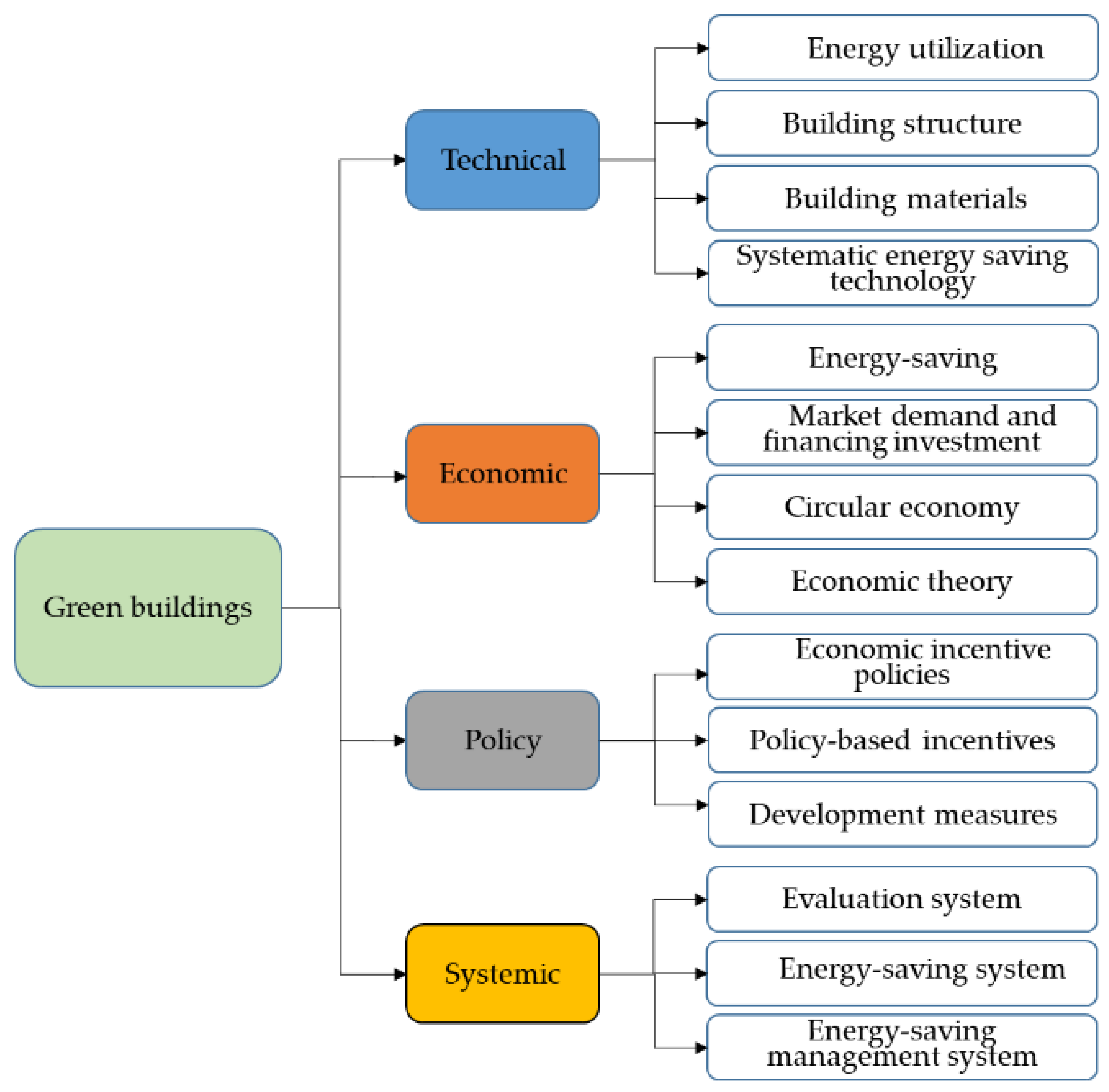
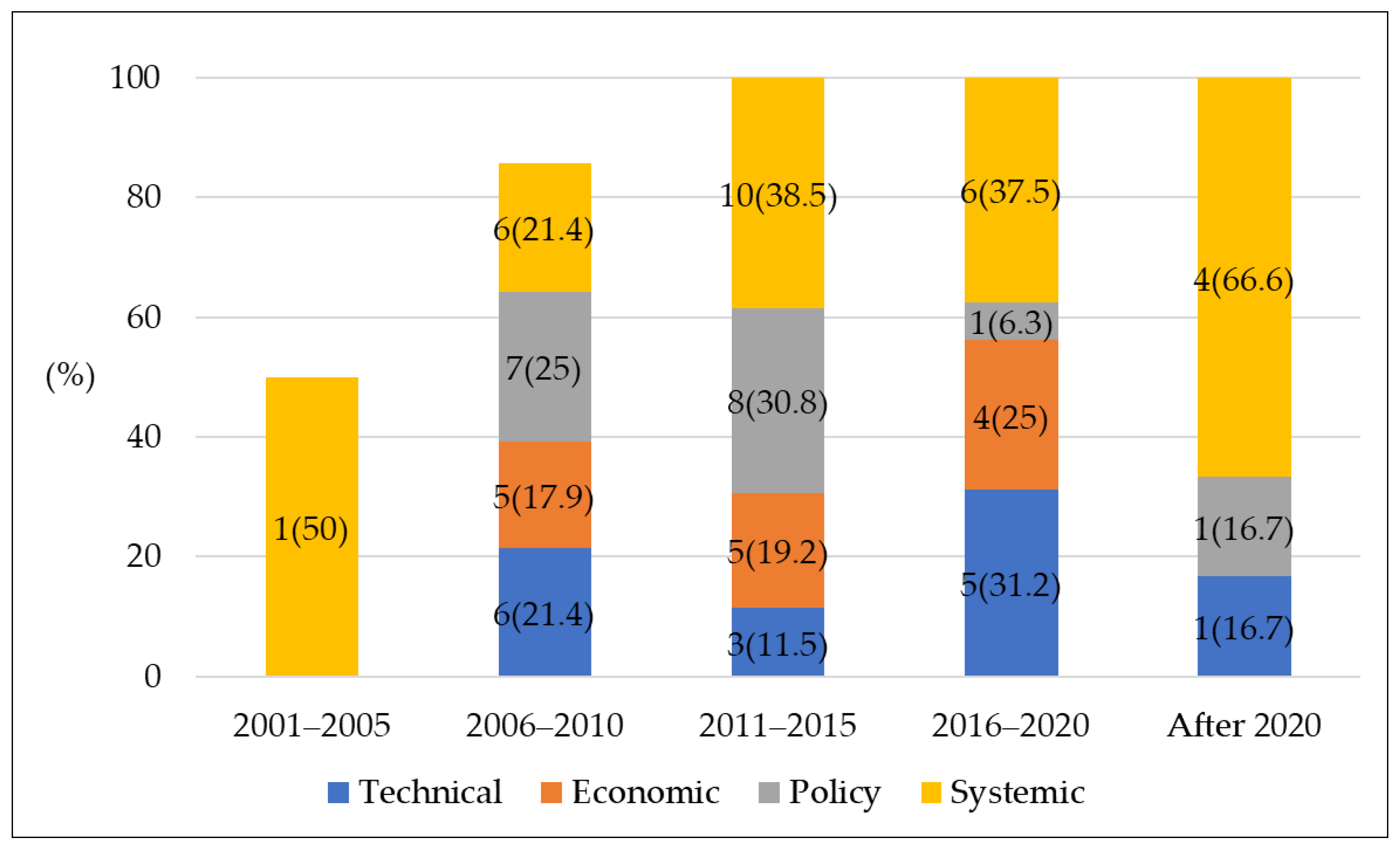
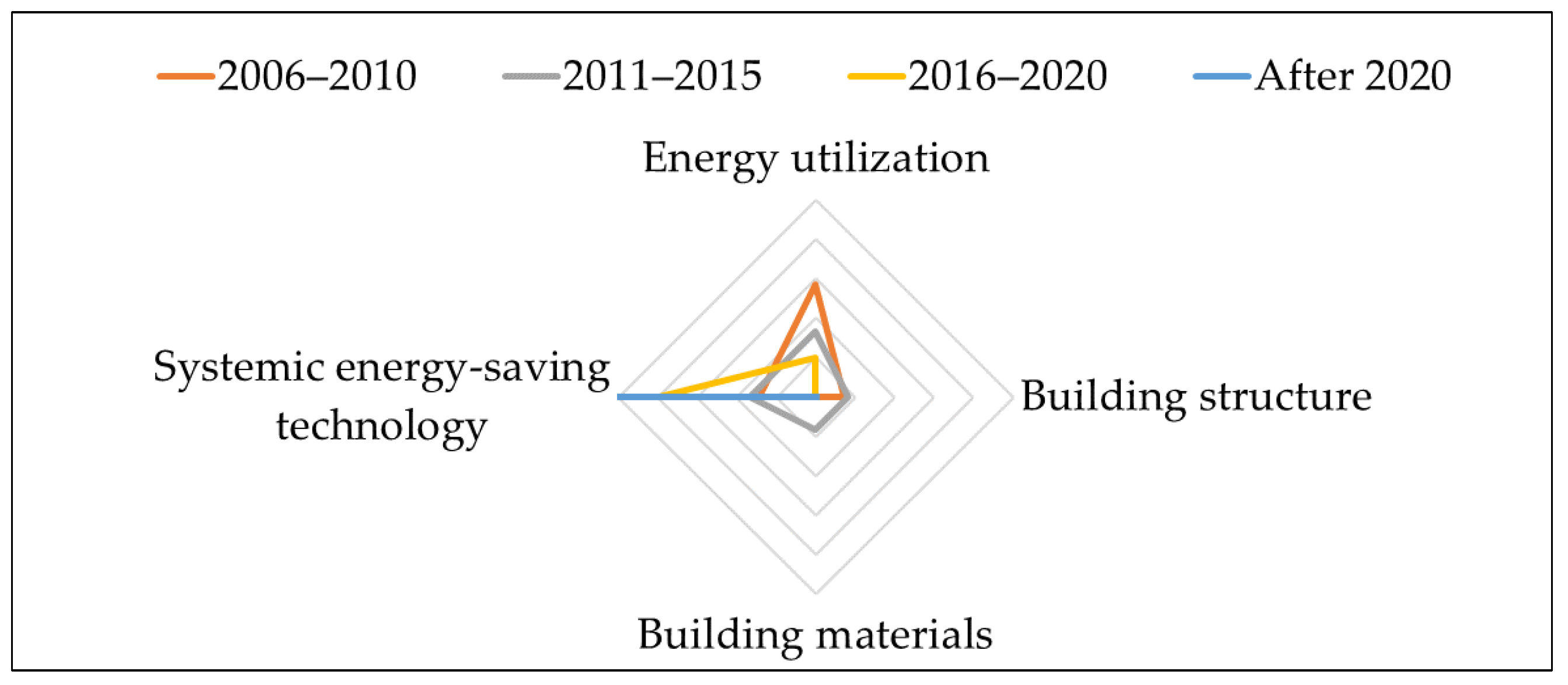
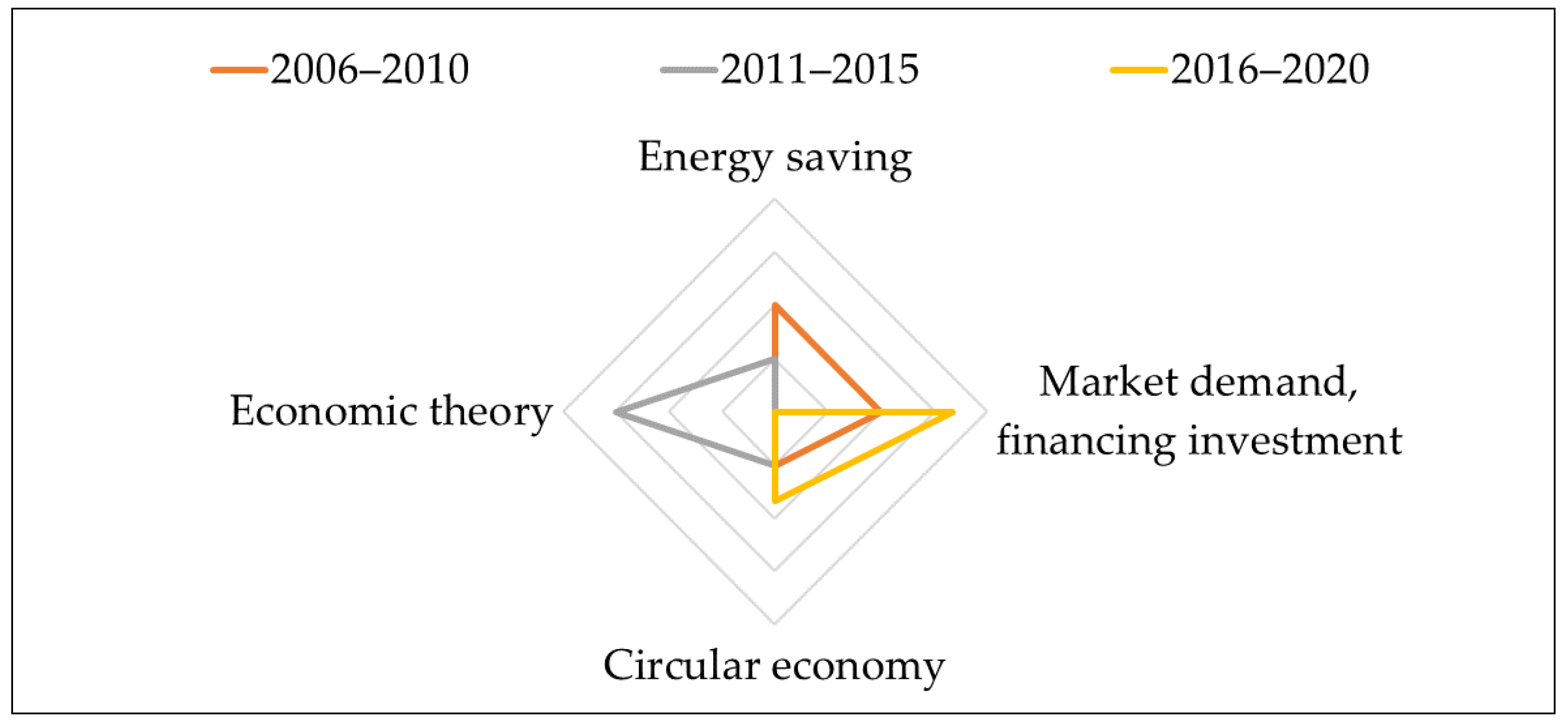
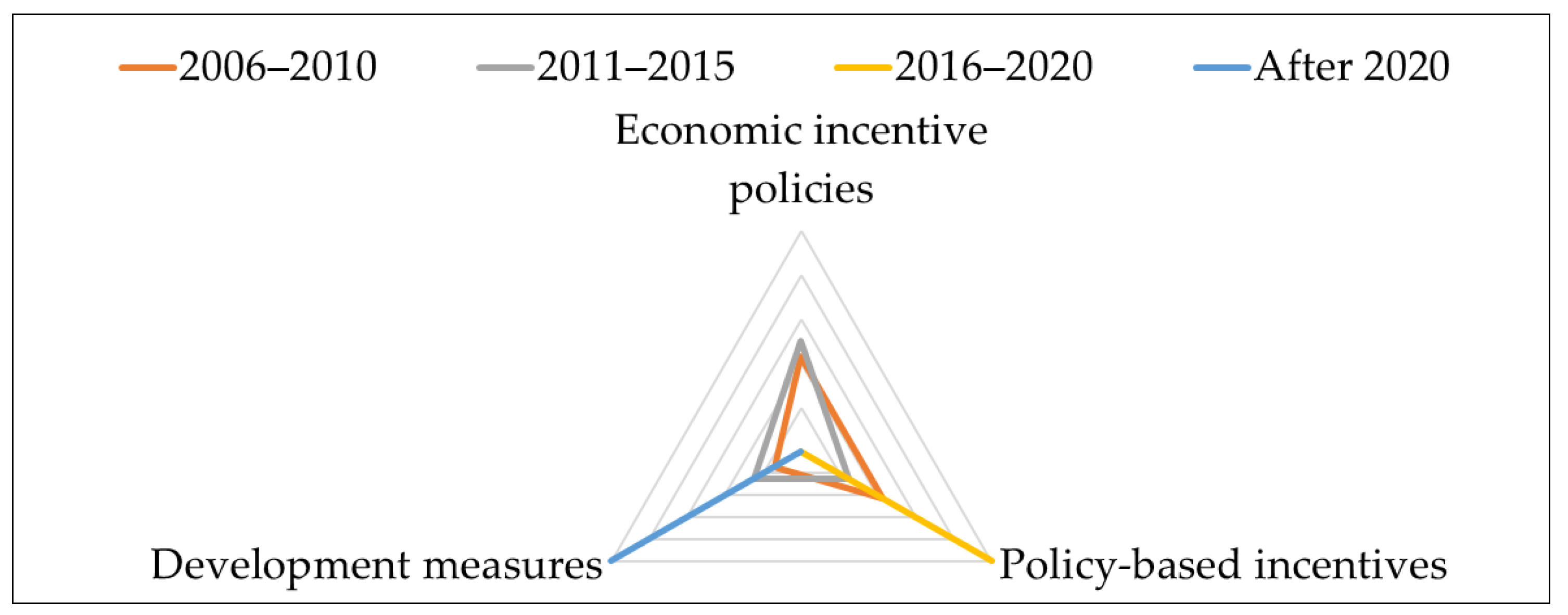
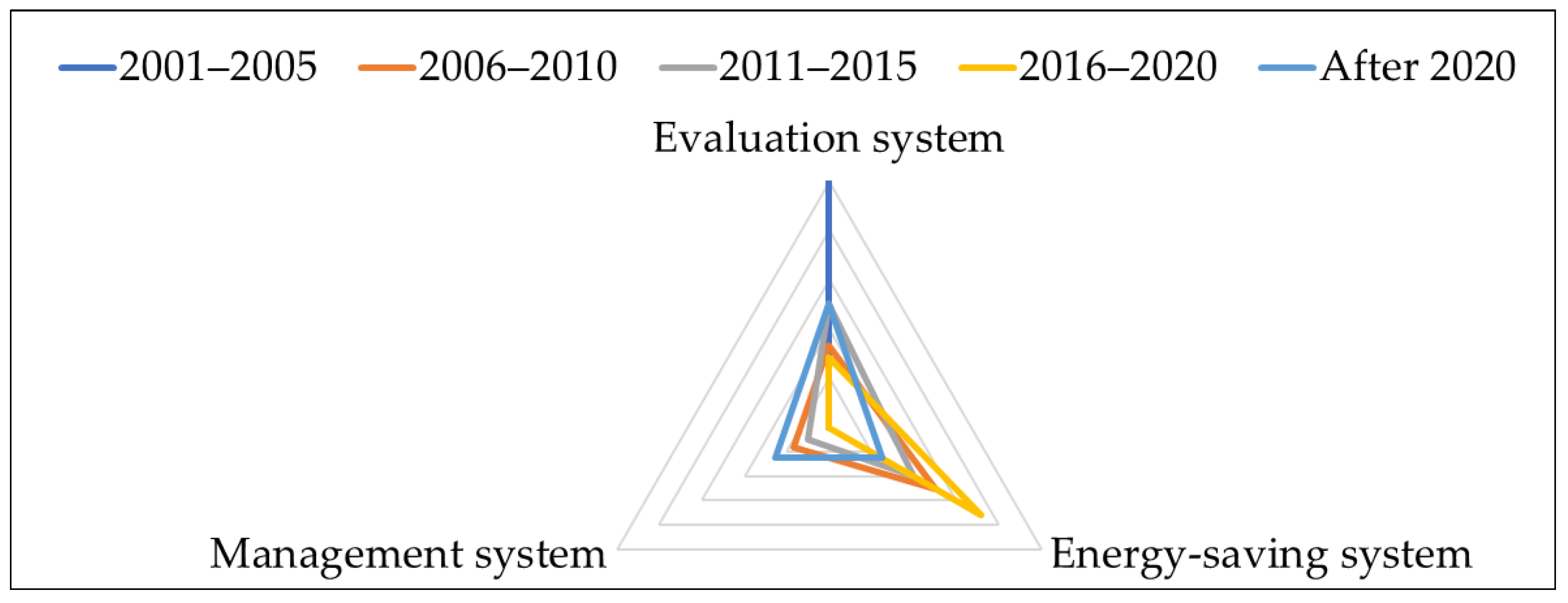
| Period | NO. | Researcher (Year) | A | B | C | D | E | F | G | H |
|---|---|---|---|---|---|---|---|---|---|---|
| 2001–2005 | 1 | Sun Jingshui (2002) [14] | O | |||||||
| 2 | Li Yunlan (2005) [15] | O | ||||||||
| 2006–2010 | 1 | Wang Xiuyan et al. (2006) [16] | O | |||||||
| 2 | Zhang Shilian et al. (2006 [17] | O | ||||||||
| 3 | Zongsheng et al. (2006) [18] | O | ||||||||
| 4 | Liu Ying et al. (2007) [19] | O | ||||||||
| 5 | Zhang Shilian et al. (2007) [20] | O | ||||||||
| 6 | Yang Zhongdong (2007) [21] | O | ||||||||
| 7 | Li Jing et al. (2007) [22] | O | ||||||||
| 8 | Chen Yingcun (2008) [23] | O | ||||||||
| 9 | Zhang Xiangrong et al. (2008) [24] | O | ||||||||
| 10 | Liu Xiuli et al. (2008) [25] | O | ||||||||
| 11 | Zhao Yuqing (2008) [26] | O | ||||||||
| 12 | Zhu Ningning et al. (2008) [27] | O | ||||||||
| 13 | Li Hui et al. (2008) [28] | O | ||||||||
| 14 | Yan Jin (2008) [29] | O | ||||||||
| 15 | Wang Jianlong et al. (2009) [30] | O | ||||||||
| 16 | Wang Ning et al. (2009) [31] | O | ||||||||
| 17 | Zhan Songlin et al. (2009) [32] | O | ||||||||
| 18 | Chen Huamin et al. (2009) [33] | O | ||||||||
| 19 | Cheng Min et al. (2009) [34] | O | O | |||||||
| 20 | Wang Ruozhu et al. (2009) [35] | O | ||||||||
| 21 | Qiu Baoxing (2009) [36] | O | ||||||||
| 22 | Wang Runxia (2010) [37] | O | ||||||||
| 23 | Yang Jie et al. (2010) [38] | O | ||||||||
| 24 | Liu Yuming et al. (2010) [39] | O | O | |||||||
| 25 | Zhang Li (2010) [40] | O | ||||||||
| 26 | Guo Liqiao (2010) [41] | O | ||||||||
| 27 | Qiu Baoxing (2011) [42] | O | O | |||||||
| 2011–2015 | 1 | Lin Lin (2011) [43] | O | O | ||||||
| 2 | Yang Xiu et al. (2011) [44] | O | ||||||||
| 3 | Li Wangming et al. (2011) [45] | O | ||||||||
| 4 | Jiang Bo et al. (2011) [46] | O | ||||||||
| 5 | Sun Ping et al. (2011) [2] | O | ||||||||
| 6 | Niu Ben et al. (2011) [47] | O | ||||||||
| 7 | Xu Binyan et al. (2011) [48] | O | O | |||||||
| 8 | Zhang Hui et al. (2011) [49] | O | O | |||||||
| 9 | Liu Yuming (2012) [50] | O | ||||||||
| 10 | Zhang Qi (2012) [51] | O | ||||||||
| 11 | Chen Manying (2012) [52] | O | ||||||||
| 12 | Dou Zhijie et al. (2012) [53] | O | ||||||||
| 13 | Ye Zuda (2012) [54] | O | ||||||||
| 14 | Sun Hongxia (2012) [55] | O | ||||||||
| 15 | Wang Fang et al. (2012) [56] | O | O | |||||||
| 16 | Anna (2012) [57] | O | ||||||||
| 17 | Qiu Baoxing (2012) [58] | O | ||||||||
| 18 | Chen Hongbo et al. (2013) [59] | O | ||||||||
| 19 | Yao Gang et al. (2013) [60] | O | O | |||||||
| 20 | Sun Yan et al. (2013) [61] | O | ||||||||
| 21 | Li Ying et al. (2014) [62] | O | ||||||||
| 22 | Shi Jiangang et al. (2014) [63] | O | ||||||||
| 23 | Wang Li et al. (2015) [64] | O | ||||||||
| 24 | Wei Xing et al. (2015) [65] | O | O | |||||||
| 2016–2020 | 1 | Huang Zhiye (2016) [66] | O | O | ||||||
| 2 | Yang Wenling (2016) [67] | O | ||||||||
| 3 | Wang Hong et al. (2017) [68] | O | O | |||||||
| 4 | Lu Bin et al. (2017) [69] | O | O | |||||||
| 5 | Sun Mingchun (2017) [70] | O | ||||||||
| 6 | Bi Xiaojian et al. (2018) [71] | O | O | |||||||
| 7 | Du Hailong et al. (2018) [72] | O | ||||||||
| 8 | Lin Yong(2019) [73] | O | O | |||||||
| 9 | Qin Wenjun et al. (2019) [74] | O | O | |||||||
| 10 | Zhao Jianxun (2019) [75] | O | ||||||||
| 11 | Ji Xiaolei et al. (2020) [76] | O | O | O | ||||||
| After 2020 | 1 | Qiu Baoxing (2021) [77] | O | |||||||
| 2 | Zhang Jingyu et al. (2021) [78] | O | O | |||||||
| 3 | Li Nanshu et al. (2022) [9] | O | ||||||||
| 4 | Wang Chong et al. (2022) [3] | O | ||||||||
| 5 | Dai Lianghua et al. (2022) [79] | O |
| Period | Research Focus |
|---|---|
| 2001–2005 | Green building concept, standards |
| 2006–2010 | Energy-saving technology, economic feasibility, incentive policies |
| 2011–2015 | Energy-saving technology, economic feasibility, incentive policies, evaluation systems (standards and improvement measures) |
| 2016–2020 | Comprehensive energy-saving technology, building energy-saving design, green finance |
| After 2020 | Digitalization and intelligence of building energy-saving designs, overall comfort of green building users |
| Period | Energy Utilization | Building Structure | Building Materials | Systemic Energy-Saving Technology |
|---|---|---|---|---|
| 2001–2005 | 0 | 0 | 0 | 0 |
| 2006–2010 | 4 | 1 | 0 | 2 |
| 2011–2015 | 2 | 1 | 1 | 2 |
| 2016–2020 | 1 | 0 | 0 | 4 |
| After 2020 | 0 | 0 | 0 | 1 |
| Period | Energy Saving | Marker Demand, Financing Investment | Circular Economy | Economic Theory |
|---|---|---|---|---|
| 2001–2005 | 0 | 0 | 0 | 0 |
| 2006–2010 | 2 | 2 | 1 | 0 |
| 2011–2015 | 1 | 0 | 1 | 3 |
| 2016–2020 | 0 | 2 | 1 | 0 |
| After 2020 | 0 | 0 | 0 | 0 |
| Period | Energy Incentive Policies | Policy-Based Incentives | Development Measures |
|---|---|---|---|
| 2001–2005 | 0 | 0 | 0 |
| 2006–2010 | 3 | 3 | 1 |
| 2011–2015 | 4 | 2 | 2 |
| 2016–2020 | 0 | 1 | 0 |
| After 2020 | 0 | 0 | 1 |
| Period | Evaluation System | Energy-Saving System | Management System |
|---|---|---|---|
| 2001–2005 | 1 | 0 | 0 |
| 2006–2010 | 2 | 3 | 1 |
| 2011–2015 | 5 | 4 | 1 |
| 2016–2020 | 2 | 5 | 0 |
| After 2020 | 2 | 1 | 1 |
Disclaimer/Publisher’s Note: The statements, opinions and data contained in all publications are solely those of the individual author(s) and contributor(s) and not of MDPI and/or the editor(s). MDPI and/or the editor(s) disclaim responsibility for any injury to people or property resulting from any ideas, methods, instructions or products referred to in the content. |
© 2023 by the authors. Licensee MDPI, Basel, Switzerland. This article is an open access article distributed under the terms and conditions of the Creative Commons Attribution (CC BY) license (https://creativecommons.org/licenses/by/4.0/).
Share and Cite
Ren, W.; Kim, K. A Study on the Green Building Trend in China—From 2001 to 2022, Focusing on Research Topic Words. Sustainability 2023, 15, 13505. https://doi.org/10.3390/su151813505
Ren W, Kim K. A Study on the Green Building Trend in China—From 2001 to 2022, Focusing on Research Topic Words. Sustainability. 2023; 15(18):13505. https://doi.org/10.3390/su151813505
Chicago/Turabian StyleRen, Weicheng, and Kyunghwan Kim. 2023. "A Study on the Green Building Trend in China—From 2001 to 2022, Focusing on Research Topic Words" Sustainability 15, no. 18: 13505. https://doi.org/10.3390/su151813505
APA StyleRen, W., & Kim, K. (2023). A Study on the Green Building Trend in China—From 2001 to 2022, Focusing on Research Topic Words. Sustainability, 15(18), 13505. https://doi.org/10.3390/su151813505





